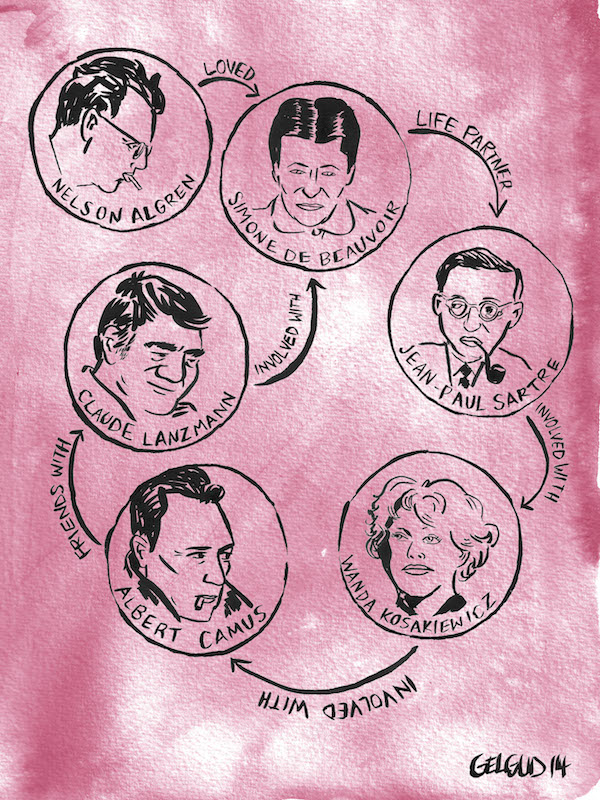6 Degrees of Infatuation: An Ode to Frisky French Writers
By Kelsey Osgood

Nathan Gelgud illustration
In honor of Valentine’s Day, we've decided to celebrate the tangled webs we weave. We're giving a bookish twist to the famous "Six Degrees of Kevin Bacon" game, attempting to delineate the six degrees of Simone de Beauvoir, the mother of feminism and memoirist extraordinaire. De Beauvoir, for those unfamiliar, presided like a matriarch over the cultural community of France. She wined and dined with the brightest existentialist philosophers and writers roaming Parisian cafes in the mid-twentieth century. No matter how far into the past you search, few romantic and intellectual bacchanalias can rival the intensity of these prurient French pals. Kiss and tell or keep it secret, without further ado we present to you the six degrees of Simone de Beauvoir!
In early 1947, Simone de Beauvoir was on a cultural tour of the United States, during which she visited Chicago for the first time. While there, she made the acquaintance of a writer one year her junior named Nelson Algren. Algren was known as the patron poet of the outcasts, though his most successful novel, The Man With the Golden Arm, wouldn’t be published for another two years. Algren and de Beauvoir kissed on their second date, and the two soon began an affair that lasted for years. (Later, Algren was incensed to find he featured heavily in her writing, occasionally under his real name.)
"Affair" is both the right word and the wrong one, because while Beauvoir wasn’t legally married, she and Jean-Paul Sartre had pledged to remain together forever when they were a mere twenty and twenty-three years old, respectively. The arrangement wasn’t exactly a conventional one, as Sartre shaped the rules of their romance so as to maximize each one’s individual freedom and (in theory) avoid jealousy. Not only were they not monogamous, Beauvoir occasionally "groomed" young women as lovers whom she would then pass over to Sartre.
One of these young women was Olga Kosakiewicz, a Russian who had previously been Beauvoir’s student. Olga, however, spurned the advances of the famously unattractive Sartre. In his devastation, he began to seduce her little sister, Wanda Kosakiewicz. It took him two years to get her in bed, and afterward she told him she hated him. Still, they remained in a sadistic embrace for seven years, until Sartre had the bright idea of casting her in his production of No Exit alongside Albert Camus.
Camus was an up-and-coming Algerian writer and philosopher far better endowed in the looks department than Sartre. He was like a Mediterranean movie star, with serious eyes, a smoldering smirk and an effortlessly chic sense of style. Wanda quickly fell for him, and the two had a brief tryst. Sartre never fully forgave Camus, who died at the age of forty-six in a car crash.
Years earlier, an ambitious young writer named Jean Cau and his friend, Claude Lanzmann, had written dozens of letters to established authors -- Camus included -- in the hopes of securing a secretarial position. Cau was hired by Sartre, who later appointed Lanzmann to the editorial board of his Communist paper Les Temps modernes. It was Lanzmann who informed Simone de Beauvoir, his lover (we’ve made it!), of Camus’ untimely passing.
Lanzmann was seventeen years younger than de Beauvoir, but that didn't stop him from assertively courting her. (When he told her he’d like to take her to a movie, she asked, "Which one?" To which he responded, "Any one.") The two remained together as a couple for seven years. It was Sartre and Beauvoir -- the parental figures of this incestuous family -- who encouraged him to write a book about his experience as a Jew in Nazi Germany and his relationship to Israel. That didn't pan out, but hey, as far as cultural contributions go, "Shoah" is nothing to sniff at.
Believe it or not, this is just a sample of Beauvoir and Sartre’s amorous couplings. For further reading on the lives, letters and love affairs of this fascinating group, check out Hazel Rowley’s Tete-a-Tete: The Tumultuous Lives and Loves of Simone de Beauvoir & Jean-Paul Sartre or Carole Seymour Jones’ A Dangerous Liaison: A Revelatory New Biography of Simone de Beauvoir and Jean-Paul Sartre.

